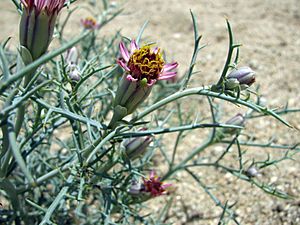Nicolletia facts for kids
Quick facts for kids Hole-in-the-sand plant |
|
|---|---|
 |
|
| Nicolletia occidentalis | |
| Scientific classification | |
| Kingdom: | |
| (unranked): | |
| (unranked): | |
| (unranked): | |
| Order: | |
| Family: | |
| Subfamily: |
Asteroideae
|
| Tribe: |
Tageteae
|
| Genus: |
Nicolletia
|
| Type species | |
| Nicolletia occidentalis |
|
Nicolletia, also known as the hole-in-the-sand plant, is a small group of flowering plants. These plants belong to the marigold tribe and are part of the large sunflower family.
Contents
What is the Hole-in-the-Sand Plant?
Nicolletia plants are unique because they often grow in sandy, dry areas. Their common name, "hole-in-the-sand plant," comes from how they seem to pop up in these tough environments. They are known for their interesting flowers, which are typical of the sunflower family.
How They Got Their Name
The genus Nicolletia was named after a famous explorer and mapmaker, Jean Nicholas Nicollet (1786–1843). He was known for his detailed maps and studies of North America. The botanist Asa Gray named this plant group in his honor.
Where Do These Plants Grow?
There are a few different types of Nicolletia plants, and each one grows in specific regions. They are mostly found in the southwestern United States and parts of Mexico.
Types of Nicolletia Plants
- Nicolletia edwardsii
- Nicolletia occidentalis (Mojave hole-in-the-sand plant)
- This type is found in Baja California in Mexico.
- It also grows in southern California in the United States, especially in the Mojave Desert.
- Nicolletia trifida
- This plant is found in Baja California and Baja California Sur, both states in Mexico.
See also
 In Spanish: Nicolletia para niños
In Spanish: Nicolletia para niños

